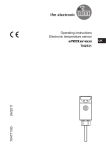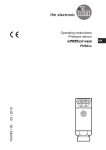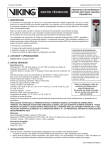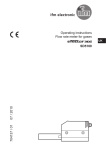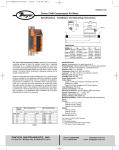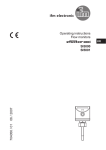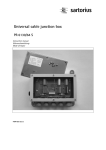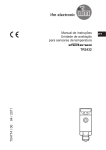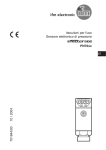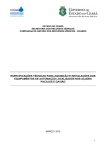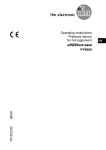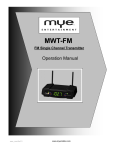Download Operating instructions Electronic temperature sensor TN7531
Transcript
Operating instructions Electronic temperature sensor UK 704772/00 04/2011 TN7531 Contents 1 Preliminary note���������������������������������������������������������������������������������������������������3 1.1 Symbols used�������������������������������������������������������������������������������������������������3 2 Safety instructions������������������������������������������������������������������������������������������������3 3 Functions and features�����������������������������������������������������������������������������������������4 4 Function����������������������������������������������������������������������������������������������������������������4 4.1 Communication, parameter setting and evaluation����������������������������������������4 4.2 Switching function������������������������������������������������������������������������������������������5 5 Installation������������������������������������������������������������������������������������������������������������6 6 Electrical connection��������������������������������������������������������������������������������������������7 7 Operating and display elements���������������������������������������������������������������������������8 8 Menu��������������������������������������������������������������������������������������������������������������������9 8.1 Menu structure�����������������������������������������������������������������������������������������������9 8.2 Explanation of the menu�������������������������������������������������������������������������������10 9 Parameter setting����������������������������������������������������������������������������������������������� 11 9.1 General parameter setting���������������������������������������������������������������������������� 11 9.2 Configuration of the display (optional)����������������������������������������������������������13 9.3. Setting of the output signals������������������������������������������������������������������������13 9.3.1 Setting of the output function���������������������������������������������������������������13 9.3.2 Setting of the switching limits��������������������������������������������������������������13 9.4 User settings (optional) �������������������������������������������������������������������������������14 9.4.1 Zero point calibration���������������������������������������������������������������������������14 9.4.2 Setting the switching delays����������������������������������������������������������������14 9.4.3 Setting of the error behaviour of the outputs���������������������������������������14 9.4.4 Setting of the switching logic for OUT1�����������������������������������������������14 9.5 Service functions������������������������������������������������������������������������������������������14 9.5.1 Reading of the min/max values for the system temperature���������������14 9.5.2 Reset of all parameters to factory setting��������������������������������������������14 10 Operation����������������������������������������������������������������������������������������������������������15 10.1 Reading of the set parameters�������������������������������������������������������������������15 10.2 Fault indication�������������������������������������������������������������������������������������������15 11 Scale drawing���������������������������������������������������������������������������������������������������16 2 12 Technical data���������������������������������������������������������������������������������������������������17 12.1 Setting ranges��������������������������������������������������������������������������������������������18 13 Factory setting��������������������������������������������������������������������������������������������������18 UK 1 Preliminary note 1.1 Symbols used ► > […] → Instruction Reaction, result Designation of pushbuttons, buttons or indications Cross-reference Important note Non-compliance can result in malfunctions or interference. 2 Safety instructions • Please read this document prior to set-up of the unit. Ensure that the product is suitable for your application without any restrictions. • Improper or non-intended use may lead to malfunctions of the unit or to unwanted effects in your application. That is why installation, electrical connection, set-up, operation and maintenance of the unit must only be carried out by qualified personnel authorised by the machine operator. • Check the compatibility of the product materials (→ 12 Technical data) with the media to be measured in all applications. 3 3 Functions and features The unit monitors the system temperature in machinery and plant. 4 Function 4.1 Communication, parameter setting and evaluation • The unit displays the current system temperature. • It generates 2 output signals according to the parameter setting. OUT1 OUT2 Switching signal for system temperature limit value. Switching signal for system temperature limit value. • It moreover provides the process data via IO-Link. • The unit is laid out for fully bidirectional communication. So, the following options are possible: -- Remote display: Reading and displaying the current system temperature. -- Remote parameter setting: Reading and changing current parameter settings with the FDT service program ifm Container or via IO-Link. -- Using the FDT service program ifm Container, the current parameter settings can be stored and transferred to other units of the same type. The program library of the available DTM objects can be found at www.ifm.com → Service → Download. Device-specific parameter lists for IO-Link parameter setting are available at: www.ifm.com → Select your country → Data sheet direct: 4 4.2 Switching function OUTx changes its switching state if it is above or below the set switching limits (SPx, rPx). The following switching functions can be selected: • Hysteresis function / normally open: [OUx] = [Hno] (→ fig. 1). • Hysteresis function / normally closed: [OUx] = [Hnc] (→ fig. 1). First the set point (SPx) is set, then the reset point (rPx) with the requested difference. • Window function / normally open: [OUx] = [Fno] (→ fig. 2). • Window function / normally closed: [OUx] = [Fnc] (→ fig. 2). The width of the window can be set by means of the difference between SPx and UK rPx. SPx = upper value, rPx = lower value. 1 T SP HY rP T SP rP t 1 0 1 0 2 FE t Hno Hnc 1 0 1 0 Fno Fnc T = system temperature; HY = hysteresis; FE = window When set to the window function the set and reset points have a fixed hysteresis of 0.25 % of the measuring range. This keeps the switching state of the output stable if the temperature varies slightly. 5 5 Installation Using process adapters the unit can be adapted to different process connections. Adapters have to be ordered separately as accessories. Immersion depth of the sensor: min. 12 mm in the pipe. If you use the adapter supplied as accessory the correct immersion depth is ensured. Mounting dimensions with G½ adapter Mounting dimensions with G¼ adapter Mounting dimensions with M12 adapter For optimum response times: ►► Orientation of the unit: Connector against the flow direction of the medium. Before installing and removing the unit: Ensure that no medium can leak at the process connection. ►► Grease the threads of the process connection (1), adapter (2) and nut (3). Note: The sensor tip (A) must not be in contact with grease. ►► Screw the suitable adapter into the process connection. ►► Place the temperature sensor onto the adapter and tighten the nut. Tightening torque max. 50 Nm. Ensure that the unit is correctly oriented. 6 6 Electrical connection The unit must be connected by a qualified electrician. The national and international regulations for the installation of electrical equipment must be adhered to. Voltage supply to EN 50178, SELV, PELV. ►► Disconnect power. ►► Connect the unit as follows: 2 x positive switching 2 x negative switching UK Pin 1 Pin 3 Ub+ Ub• Binary switching output temperature monitoring. Pin 4 (OUT1) • Data channel for bidirectional communication. Pin 2 (OUT2) • Binary switching output temperature monitoring. Core colours of ifm sockets: 1 = BN (brown), 2 = WH (white), 3 = BU (blue), 4 = BK (black) 7 7 Operating and display elements 1 to 8: Indicator LEDs -- LED 1: Current temperature in °C. -- LED 2: Current temperature in °F. -- LED 7, LED 8 = switching state of the corresponding output. 9: Alphanumeric display, 4 digits -- Display of the current system temperature. -- Indication of the parameters and parameter values. 10: Set button -- Setting of the parameter values (scrolling by holding pressed; incrementally by pressing once). 11: Mode/Enter button -- Selection of the parameters and acknowledgement of the parameter values. 8 8 Menu 8.1 Menu structure UK 9 8.2 Explanation of the menu SP1/rP1 Upper / lower limit value for system temperature at which OUT1 switches. SP2/rP2 Upper / lower limit value for system temperature at which OUT2 switches. OU1 Output function for OUT1: Switching signal for the temperature limit values: Hysteresis function [H ..] or window function [F ..], either normally open [. no] or normally closed [. nc]. OU2 Output function for OUT2: Switching signal for the temperature limit values: Hysteresis function [H ..] or window function [F ..], either normally open [. no] or normally closed [. nc]. EF Extended functions / opening of menu level 2. HI Maximum value memory for system temperature. LO Minimum value memory for system temperature. COF Zero-point calibration. dS1 / dS2 Switch-on delay for OUT1 / OUT2 dr1 / dr2 Switch-off delay for OUT1 / OUT2. FOU1 Behaviour of output 1 in case of an internal fault. FOU2 Behaviour of output 2 in case of an internal fault. P-n Output logic: pnp / npn. diS Update rate and orientation of the display. Uni Unit of measurement for system temperature. rES Restore factory settings. 10 9 Parameter setting During parameter setting the unit remains in the operating mode. It continues its monitoring function with the existing parameters until the parameter setting has been completed. 9.1 General parameter setting 3 steps must be taken for each parameter setting: 1 Selection of the parameter ►► Press [Mode/Enter] until the requested parameter is displayed. UK 2 Setting of the parameter value ►► Press [Set] and keep it pressed. >> Current setting value of the parameter flashes for 5 s. >> After 5 s: Setting value is changed: incrementally by pressing the button once or continuously by keeping the button pressed. Numerical values are incremented continuously. For reducing the value: Let the display move to the maximum setting value. Then the cycle starts again at the minimum setting value. 3 Acknowledgement of the parameter value ►► Press [Mode/Enter] briefly. >> The parameter is displayed again. The new setting value is stored. Setting of other parameters ►► Start again with step 1. Finishing the parameter setting ►► Press [Mode/Enter] several times until the current measured value is displayed or wait for 15 s. >> The unit returns to the operating mode. • If [SLoc] is displayed when attempting a modification of a parameter value, the sensor is locked via software. This locking can only be removed via a parameter setting software. • In case of parameter setting with the user interface of the ifm Container program, the values can be directly entered in the specified fields. • For IO-Link parameter setting → device-specific parameter lists at: www.ifm.com → Select your country → Data sheet direct: 11 • Change from menu level 1 to menu level 2: ►► Press [Mode/Enter] until [EF] is displayed. If the submenu is protected with an access code, [Cod1] flashes in the display. ►► Press [Set] and keep it pressed until the valid code no. is displayed. ►► Press [Mode/Enter] briefly. On delivery by ifm electronic: no access restriction. ►► Press [Set] briefly. >> The first parameter of the sub-menu is displayed (here: [HI]). With the user interface of the ifm Container program: ►► Activate the [EF] button. If menu level 2 is protected by an access code, the input field for the code no. is activated. ►► Enter valid code no. • Locking / unlocking The unit can be locked electronically to prevent unintentional settings. ►► Make sure that the unit is in the normal operating mode. ►► Press [Mode/Enter] + [Set] for 10 s. >> [Loc] is displayed. During operation: [Loc] is briefly displayed if you try to change parameter values. For unlocking: ►► Press [Mode/Enter] + [Set] for 10 s. >> [uLoc] is displayed. On delivery: unlocked. • Timeout: If no button is pressed for 15 s during parameter setting, the unit returns to the operating mode with unchanged values. 12 9.2 Configuration of the display (optional) ►► Select [Uni] and set the unit of measurement: [°C] or [°F]. ►► Select [diS] and set the update rate and orientation of the display: -- [d1]: Update of the measured values every 50 ms. -- [d2]: Update of the measured values every 200 ms. -- [d3]: Update of the measured values every 600 ms. -- [rd1], [rd2], [rd3]: Display as for d1, d2, d3; rotated by 180°. -- [OFF]: The display is switched off in the operating mode. 9.3. Setting of the output signals 9.3.1 Setting of the output function UK ►► Select [OU1] and set the function: -- [Hno] = Hysteresis function / normally open. -- [Hnc] = Hysteresis function / normally closed. -- [Fno] = Window function / normally open. -- [Fnc] = Window function / normally closed. ►► Select [OU2] and set the function: -- [Hno] = Hysteresis function / normally open. -- [Hnc] = Hysteresis function / normally closed. -- [Fno] = Window function / normally open. -- [Fnc] = Window function / normally closed. 9.3.2 Setting of the switching limits ►► Select [SP1] / [SP2] and set the value at which the output switches. ►► Select [rP1] / [rP2] and set the value at which the output switches off. rPx is always smaller than SPx. The unit only accepts values which are lower than the value for SPx. 13 9.4 User settings (optional) 9.4.1 Zero point calibration ►► Select [COF] and enter value. Setting range: -10.0...10.0 °C in steps of 0.1 °C. -18.0 ...18.0 °F in steps of 0.1° F. The internal measured value "0" is shifted by this value. 9.4.2 Setting the switching delays [dS1] / [dS2] = switch-on delay for OUT1 / OUT2. [dr1] / [dr2] = switch-off delay for OUT1 / OUT2. ►► Select [dS1], [dS2], [dr1] or [dr2] and set a value between 0.1 and 50 s (at 0.0 the delay time is not active). 9.4.3 Setting of the error behaviour of the outputs ►► Select [FOU1] or [FOU2] and set the value: -- [On] = Output 1 / 2 switches ON in case of a fault. -- [OFF] = Output 1 / 2 switches OFF in case of a fault. 9.4.4 Setting of the switching logic for OUT1 ►► Select [P-n] and set [PnP] or [nPn]. 9.5 Service functions 9.5.1 Reading of the min/max values for the system temperature ►► Select [HI] or [LO], briefly press [Set]. [HI] = maximum value, [LO] = minimum value. Delete memory: ►► Select [HI] or [LO]. ►► Press [Set] and keep it pressed until [----] is displayed. ►► Press [Mode/Enter] briefly. 9.5.2 Reset of all parameters to factory setting ►► Select [rES]. ►► Press [Set] and keep it pressed until [----] is displayed. ►► Press [Mode/Enter] briefly. We recommend taking down your own settings in the table before carrying out a reset (→ 13 Factory setting). 14 10 Operation After power on, the unit is in the Run mode (= normal operating mode). It carries out its measurement and evaluation functions and provides output signals according to the set parameters. Operating indications → Chapter 7 Operating and display elements. 10.1 Reading of the set parameters ►► Press [Mode/Enter] until the requested parameter is displayed. ►► Press [Set] briefly. >> The unit displays the corresponding parameter value for about 15 s. After another 15 s the unit returns to the Run mode. UK 10.2 Fault indication [OL] Temperature too high (measuring range exceeded by more than 3% of the final value of the measuring range). [UL] Temperature too low (measuring range below the final value of the measuring range by more than 10%). [Err] Detection zone is exceeded (T < -60°C or T > +160°C). [SC1] Short circuit in OUT1* [SC2] Short circuit in OUT2* [SC] Short circuit in both switching outputs* [Loc] Setting pushbuttons of the unit locked, parameter change rejected. [SLoc] Unit locked via software, parameter change rejected. [PARA] Setting value of a parameter outside the valid range → the unit is not ready for operation. The error may occur with IO-Link parameter setting. If an invalidly set parameter is activated, [PARA] is displayed instead of the parameter value. *The output concerned is switched off as long as the short circuit exists. The messages Err, PARA and SC1 are shown even if the display is switched off. Response of the outputs in case of a parameter setting fault [PARA]: Invalid setting [OU1] / [OU2] Invalid setting [FOU1] / [FOU2] Invalid setting [P-n] Invalid setting of other parameters OUT1 OFF OFF OFF acc. to setting [FOU1] OUT2 OFF OFF OFF acc. to setting [FOU2] 15 11 Scale drawing Dimensions in mm 1: Display 2: LEDs 3: Programming button 4: Internal thread M18x1.5 16 12 Technical data Measuring range [°C / °F]....................................................................... -40...150 / -40...302 Communication interface .................................................................................... IO-Link 1.0 Baud rate [kBAUD]......................................................................................................... 38.4 Operating voltage [V]............................................................................................ 18...32 DC Current rating [mA].......................................................................................................... 250 Short-circuit protection (pulsed); protected against reverse polarity and overload Integrated watchdog Voltage drop [V] ................................................................................................................< 2 Current consumption [mA] ..............................................................................................< 50 UK Measuring element...................................1 x PT 1000 according to DIN EN 60751, class B Dynamic response T05/T09 [s]......................................................... 1 / 3 (to DIN EN 60751) Accuracy (the values apply to flowing water) - switching output [K]......................................................................................................± 0.3 - display [K].....................................................................................................................± 0.3 Resolution - switching output [K].........................................................................................................0.1 - display [K]........................................................................................................................0.1 Housing materials.................................... stainless steel (304S15); EPDM/X (Santoprene); PC Copolymer; PBT (Pocan) FPM (Viton) PA Materials (wetted parts).......................................................... stainless steel 316L / 1.4404; O-ring: FPM 8 x 1.5 gr 80° Shore A Operating temperature [°C]...................................................................................... -25...70 Storage temperature [°C] ......................................................................................... -40...85 Pressure resistance [bar].................................................................................................300 Protection rating ........................................................................................................... IP 67 Protection class...................................................................................................................III Shock resistance [g]............................................................... 50 (DIN / IEC 68-2-27, 11 ms) Vibration resistance [g]................................................... 20 ( DIN / IEC 68-2-6, 10-2000 Hz) EMC EN 61000-4-2 ESD: ....................................................................... 4 kV CD / 8 kV AD EN 61000-4-3 HF radiated: ............................................................................. 10 V/m EN 61000-4-4 Burst: ............................................................................................ 2 kV EN 61000-4-5 Surge: ........................................................................................... 1 kV EN 61000-4-6 HF conducted: ............................................................................. 10 V 17 12.1 Setting ranges SP1 / SP2 °C °F min -39.8 -39.6 rP1 / rP2 max 150.0 302.0 min -40.0 -40.0 max 149.8 301.6 ∆T 0.1 0.1 ∆T = step increment 13 Factory setting Factory setting SP1 60.0 rP1 50.0 OU1 Hno OU2 Hno SP2 120.0 rP2 100.0 COF 0.0 dS1 0.0 dr1 0.0 dS2 0.0 dr2 0.0 FOU1 OFF FOU2 OFF P-n PnP diS d2 Uni °C Further information at www.ifm.com 18 User setting


















